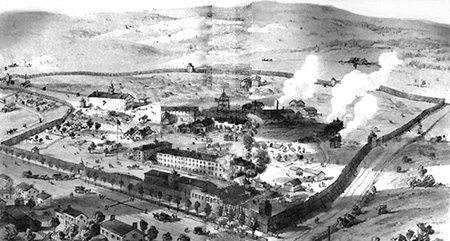
NYCHS composite of Clinton Prison illustration in 1869 State Senate documents volume.*
(part 1: the labor problem context) |
||
|
by Ron Roizen When in March, 1844, the legislation to create Clinton Prison passed the state assembly, an enthusiastic rally of artisans in New York City dispatched a petition with 4,500 signatures to the senate, urging them to take similar action. Although it was Ransom Cook, a Saratoga County inventor, who conceived the idea of a prison outside Plattsburgh, the workers of an increasingly industrialized New York City were the force behind its creation.
Around the turn of the century, two penal systems existed in the United States, the Pennsylvania system and the Auburn system. The Auburn system of congregate silence coupled with hard labor was, in part, attractive to legislators because it promised to produce revenue while the Pennsylvania system, with its commitment to solitary confinement, was financially handicapped. Prisons, and more especially, prisoners, were expected to be self-supporting. Indeed, even contemporary humanitarians feared that a prison which required subsidies from the taxpayer would increase the people's wrath toward criminals and prompt the reintroduction of sanguinary punishments which had only recently been done away with. Although New York prisons confronted manifold difficulties in achieving self-sufficiency, entrepreneurial wardens and ascetic inmate circumstances could be combined to turn a profit. In the decade prior to that of Clinton's founding, both Auburn and Sing Sing prisons earned annual surpluses. . . . . The type of penal industry which made [governmental frugality] possible, however, did not find favor among all citizens. In particular, the prison workshops were bitterly criticized by many free artisans who in time succeeded in obtaining restrictive legislation against what they regarded as unfair competition. These efforts, together with the activities of reformers who opposed prevailing penal methods for other reasons, helped to usher in a new phase in the development of the penitentiary system in New York. (ND, p. 186-187) Artisans themselves were under pressure from the growing supply of cheap goods which were being produced by assembly lines and machinery. Additionally, the low esteem in which felons were held served to fan the artisans, hostility. This arrangement contravened the laissez-faire sentiments of the Jacksonian era. Were these objections not enough, working men were threatened by the infiltration to their ranks by ex-felons after they had served their terms.
By association with prison laborers, craftsmanship was being insulted. Other detractors of prison labor were also dubious about the partnership between government-supplied labor (in the form of prisoners) and private business.On May 11, 1835, following an assembly committee study of the possibilities, the legislature voted to restrict prison contracts, outlaw the training of prisoners for the making of an article which was domestically produced, and suggested that New York penal institutions take up the growing of mulberry trees and the production of silkworms. Prison enterprise, in other words, was to be restricted to products which were imported. The contract system was altered to fit the legislative restrictions -- (one unintended consequence was the breaking up of production systems into fractional pieces such that prisoner labor could be used without technically violating the proscription on prisoner training.) Silk production, as Lewis termed it, was "grumblingly" taken up by Auburn and Sing Sing. Silk production proved to be unprofitable; moreover, the noise of the silk machines was allowing prisoners to talk to one another, which of course was contrary to the Auburn system. Furthermore, the evasions of the 1835 restrictions by prison officials was again causing strong objections from artisans. This time, however, workingmen lobbied for the abolition of prisoner competition altogether, through the end of the contract system; the prohibition of trades-teaching within prisons; the banning of machinery and machinery energy sources; and the replacement of the Auburn system with the Pennsylvania system. On April 9, 1842, the legislature enacted a bill sufficiently explicit and restrictive to bring prison competition in the State to a temporary end. |
| <-- previous | next ---> |